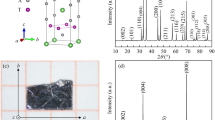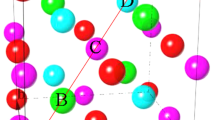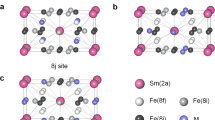Abstract
The magnetocaloric effect (MCE) in paramagnetic materials has been widely used for attaining very low temperatures by applying a magnetic field isothermally and removing it adiabatically. The effect can also be exploited for room-temperature refrigeration by using giant MCE materials1,2,3. Here we report on an inverse situation in Ni–Mn–Sn alloys, whereby applying a magnetic field adiabatically, rather than removing it, causes the sample to cool. This has been known to occur in some intermetallic compounds, for which a moderate entropy increase can be induced when a field is applied, thus giving rise to an inverse magnetocaloric effect4,5. However, the entropy change found for some ferromagnetic Ni–Mn–Sn alloys is just as large as that reported for giant MCE materials, but with opposite sign. The giant inverse MCE has its origin in a martensitic phase transformation that modifies the magnetic exchange interactions through the change in the lattice parameters.
This is a preview of subscription content, access via your institution
Access options
Subscribe to this journal
Receive 12 print issues and online access
$259.00 per year
only $21.58 per issue
Buy this article
- Purchase on Springer Link
- Instant access to full article PDF
Prices may be subject to local taxes which are calculated during checkout




Similar content being viewed by others
References
Pecharsky, V. K. & Gschneidner, K. A. Jr Giant magnetocaloric effect in Gd5(Si2Ge2). Phys. Rev. Lett. 78, 4494–4497 (1997).
Pecharsky, V. K. & Gschneidner K. A. Jr Gd5(SixGe1−x)4: an extremum material. Adv. Mater. 13, 683–686 (2001).
Tegus, O., Brück, E., Buschow, K. H. J. & de Boer, F. R. Transition-metal-based magnetic refrigerants for room-temperature applications. Nature 415, 150–152 (2002).
Tegus, O. et al. Magnetic phase transitions and magnetocaloric effects. Physica B 319, 174–192 (2002).
Zhang, Y. Q. & Zhang, Z. D. Giant magnetoresistance and magnetocaloric effects of the Mn1.82 V0.18Sb compound. J. Alloys Comp. 365, 35–38 (2004).
Provenzano, V., Shapiro, A. J. & Shull R. D. Reduction of hysteresis losses in the magnetic refrigerant Gd5Si2Ge2 by addition of iron. Nature 429, 853–857 (2004).
Pecharsky, V. K. & Gschneidner, K. A. Jr Tunable magnetic regenerator alloys with a giant magnetocaloric effect for magnetic refrigeration from ∼20 to ∼290 K. Appl. Phys. Lett. 70, 3299–3301 (1997).
Nikitin, S. A. et al. The magnetocaloric effect in Fe49Rh51 compound. Phys. Lett. A 148, 363–366 (1990).
Pareti, L., Solzi, M., Albertini, F. & Paoluzi, A. Giant entropy change at the co-occurrence of structural and magnetic transitions in the Ni2.19Mn0.81Ga Heusler alloy. Eur. Phys. J. B 32, 303–307 (2003).
Marcos, J. et al. Magnetic field induced entropy change and magnetoelasticity in Ni–Mn–Ga alloys. Phys. Rev. B 66, 224413 (2002).
Marcos, J. et al. Multiscale origin of the magnetocaloric effect in Ni–Mn–Ga shape-memory alloys. Phys. Rev. B 68, 094401 (2003).
Hu, F., Shen, B. & Sun, J. Magnetic entropy change in Ni51.5Mn22.7Ga25.8 alloy. Appl. Phys. Lett. 76, 3460–3462 (2000).
Krenke, T. et al. Martensitic transitions and the nature of ferromagnetism in the austenitic and martensitic states of Ni–Mn–Sn alloys. Phys. Rev. B (in the press).
Duman, E., Acet, M., Elerman, Y., Elmali, A. & Wassermann, E. F. Magnetic interactions in Pr1−xTbxMn2Ge2 . J. Magn. Magn. Mater. 238, 11–21 (2002).
Tishin, A. M. & Spichkin, Y. I. The Magnetocaloric Effect and its Applications (Institute of Physics, Bristol, 2003).
Sasioglu, E., Sandratskii, L. M. & Bruno, P. First-principles calculation of the intersublattice exchange interactions and Curie temperatures of the full Heusler alloys Ni2MnX (X=Ga, Sn, Sb). Phys. Rev. B 70, 024427 (2004).
Joenk, R. J. Adiabatic magnetisation of antiferromagnets. J. Appl. Phys. 34, 1097–1098 (1963).
Acknowledgements
This work was supported by Deutsche Forschungsgemeinschaft (GK277) and CICyT (Spain), project MAT2004-1291. X.M. acknowledges support from DGICyT (Spain).
Author information
Authors and Affiliations
Corresponding author
Ethics declarations
Competing interests
The authors declare no competing financial interests.
Rights and permissions
About this article
Cite this article
Krenke, T., Duman, E., Acet, M. et al. Inverse magnetocaloric effect in ferromagnetic Ni–Mn–Sn alloys. Nature Mater 4, 450–454 (2005). https://doi.org/10.1038/nmat1395
Received:
Accepted:
Published:
Issue Date:
DOI: https://doi.org/10.1038/nmat1395
This article is cited by
-
Proposed Compositions in a Ni-Mn-Ga System for Magnetocaloric Applications
Journal of Electronic Materials (2024)
-
Disorder-Driven Magnetic Properties of Co2TiSi and Co2TiAl Heusler Alloys
Metallurgical and Materials Transactions A (2024)
-
Combining Ab Initio and Monte Carlo Methods to Study the Electronic, Magnetic, and Magnetocaloric Properties of \(\hbox {GaFeCo}_2\) Full-Heusler Material
Journal of Electronic Materials (2024)
-
Unraveling magnetic properties and martensitic transformation in Mn-rich Ni–Mn–Sn alloys: first-principles calculations and experiments
Rare Metals (2024)
-
Effect of Sintering Temperature on the Magnetocaloric Effect of Ni-Mn-In/Tb-Dy-Fe Composites
Journal of Superconductivity and Novel Magnetism (2024)



